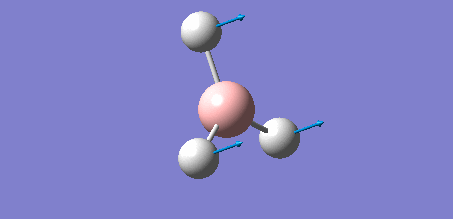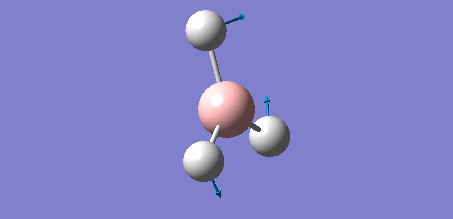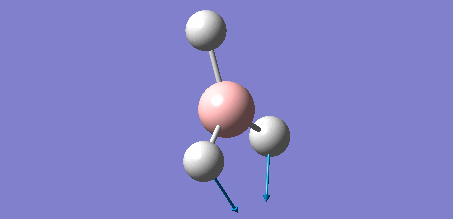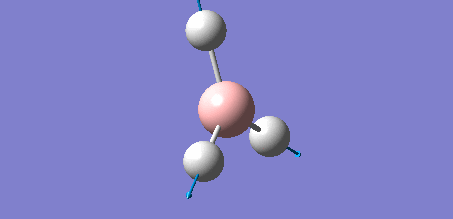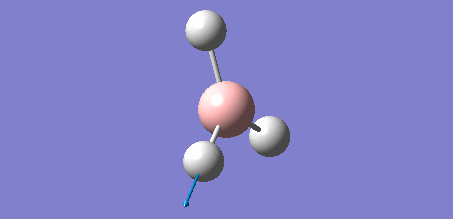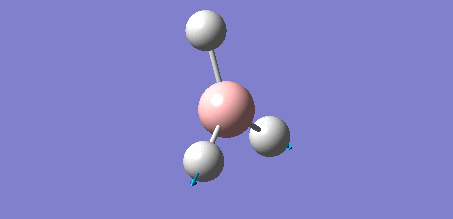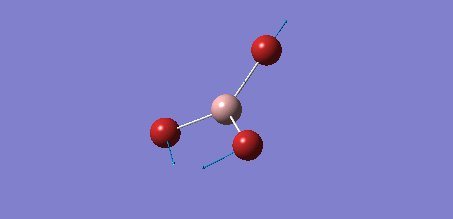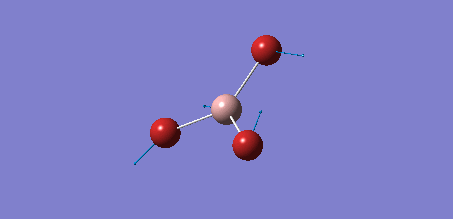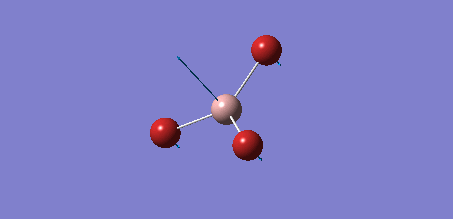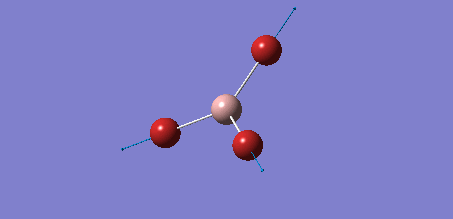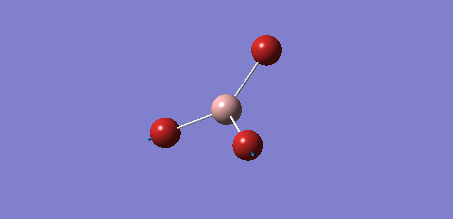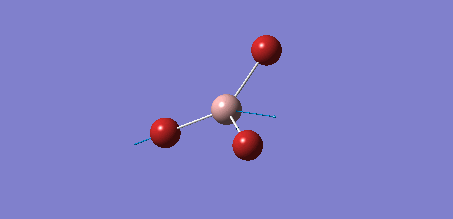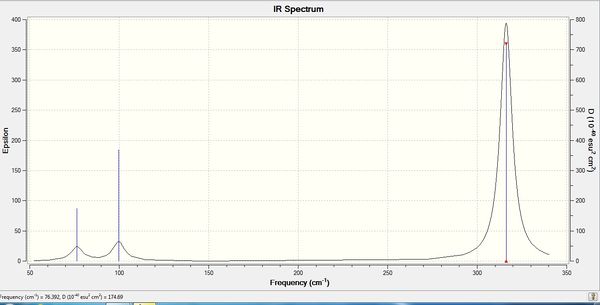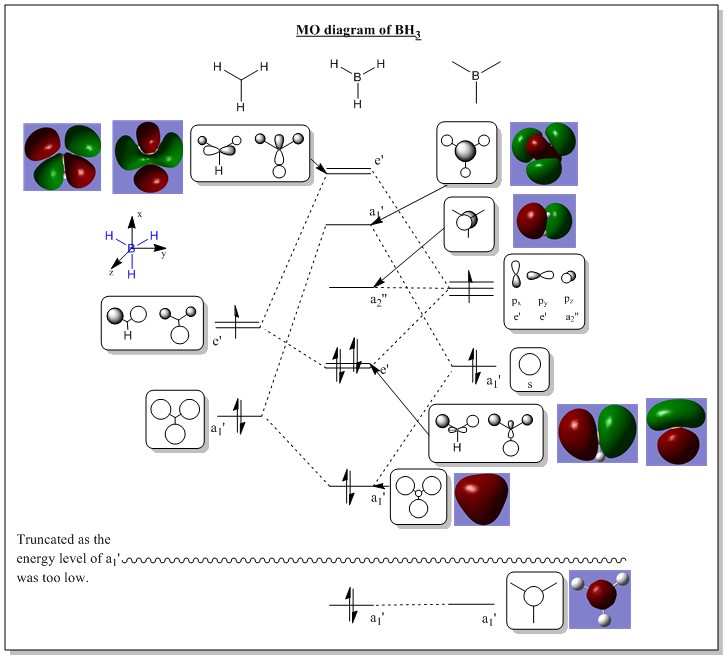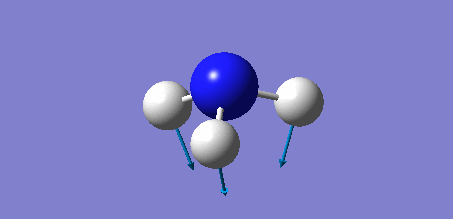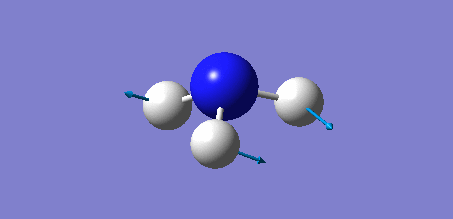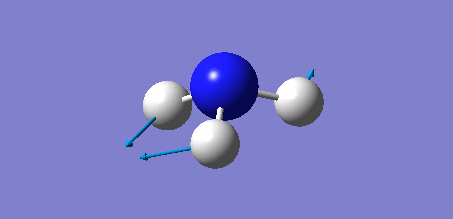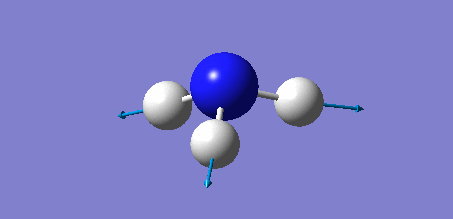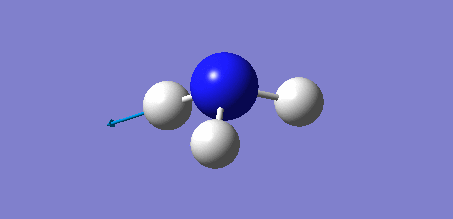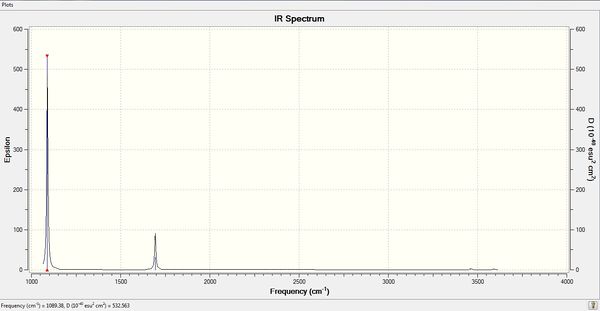Rep:Mod:ttyr2202versionold
3rd Year Computational Chemistry Laboratory 2013 (Part One)
Name: YONG REN TAN (CID:00703262)
BH3 optimisation
BH3 OPTIMIZATION using 3-21G basis set
Computational analysis of BH3 was investigated using Gaussian 09. It was optimized using the DFT B3LYP/3-21G calculations. The log data of the calculation would be found from the link below:
The data below shows the details and the results of the calculation. The energy obtained was -26.46226338 a.u. The optimisation was complete as the RMS Gradient Norm is less than 0.001 a.u.
| File Type | .log |
| Calculation Type | FOPT |
| Calculation Method | RB3LYP |
| Basis Set | 3-21G |
| Charge | 0 |
| Spin | Singlet |
| E(RB3LYP) | -26.46226338 a.u. |
| RMS Gradient Norm | 0.00020672 a.u. |
| Imaginary Freq | nil |
| Dipole Moment | 0.0000 Debye |
| Point Group | D3h |
| Job cpu time | 26.0 seconds |
Also, the job had already converged. It was proven from the data below showing that the full convergence after the job.
Item Value Threshold Converged?
Maximum Force 0.000413 0.000450 YES
RMS Force 0.000271 0.000300 YES
Maximum Displacement 0.001610 0.001800 YES
RMS Displacement 0.001054 0.001200 YES
Predicted change in Energy=-1.071764D-06
Optimization completed.
-- Stationary point found.
From the calculation, it was found that BH3 has the following data for bond length and bond angle.
Bond length (H-B) : 1.19 Å
Bond angle (H-B-H) : 120.0 deg
BH3 OPTIMIZATION using 6-31G(d,p) basis set
Another computational analysis of BH3 was investigated using Gaussian 09. It was optimized using the DFT B3LYP/6-31G(d,p) calculations. The log data of the calculation would be found from the link below:
The data below shows the details and the results of the calculation. The energy obtained was -26.61532252 a.u. The optimisation was complete as the RMS Gradient Norm is less than 0.001 a.u.
| File Type | .log |
| Calculation Type | FOPT |
| Calculation Method | RB3LYP |
| Basis Set | 6-31G(d,p) |
| Charge | 0 |
| Spin | Singlet |
| E(RB3LYP) | -26.61532252 a.u. |
| RMS Gradient Norm | 0.00021672 a.u. |
| Imaginary Freq | nil |
| Dipole Moment | 0.0000 Debye |
| Point Group | D3h |
| Job cpu time | 30.0 seconds |
Furthermore, the job had already converged. It was proven from the data below showing that the full convergence after the job.
Item Value Threshold Converged?
Maximum Force 0.000433 0.000450 YES
RMS Force 0.000284 0.000300 YES
Maximum Displacement 0.001702 0.001800 YES
RMS Displacement 0.001114 0.001200 YES
Predicted change in Energy=-1.189019D-06
Optimization completed.
-- Stationary point found.
From the calculation, it was found that BH3 has the following data for bond length and bond angle.
Bond length (B-H): 1.19143 Å
Bond angle (H-B-H): 120 deg.
Summary
| Basis set | 3-21G | 6-31G(d,p) |
|---|---|---|
| Energy (a.u.) | -26.46226338 | -26.61532252 |
The energy difference is 0.15305914 a.u., which is about 402 kJ mol-1
GaBr3 and BBr3 optimisation
GaBr3
Computational analysis of GaBr3 was investigated using Gaussian 09. It was optimized using the DFT B3LYP/LanL2DZ calculations. It is of a medium level basis set. Other than that, to ensure that the calculation is more accurate, the geometry was restricted to D3h, with the tolerance set to be very tight (0.0001).The log data of the calculation would be found from the link below:
The data below shows the details and the results of the calculation. The energy obtained was -41.70082783 a.u. The optimisation was complete as the RMS Gradient Norm is close to 0 a.u.
| File Type | .log |
| Calculation Type | FOPT |
| Calculation Method | RB3LYP |
| Basis Set | LANL2DZ |
| Charge | 0 |
| Spin | Singlet |
| E(RB3LYP) | -41.70082783 a.u. |
| RMS Gradient Norm | 0.00000016 a.u. |
| Imaginary Freq | nil |
| Dipole Moment | 0.0000 Debye |
| Point Group | D3h |
| Job cpu time | 27.8 seconds |
Also, the job had already converged. It was proven from the data below showing that the full convergence after the job.
Item Value Threshold Converged?
Maximum Force 0.000000 0.000450 YES
RMS Force 0.000000 0.000300 YES
Maximum Displacement 0.000003 0.001800 YES
RMS Displacement 0.000002 0.001200 YES
Predicted change in Energy=-1.282676D-12
Optimization completed.
-- Stationary point found.
From the calculation, it was found that GaBr3 has the following data for bond length and bond angle.
Bond length (Br-Ga) : 2.39000 Å
Bond angle (Br-Ga-Br) : 120 deg
In comparison with the literature, the bond length of Br-Ga is (...)
BBr3
Computational analysis of BBr3 was investigated using Gaussian 09. It was optimized using the DFT B3LYP/GEN calculations. The basis sets for each atom was individually specified. In the input file, it was specified that it was the basis set for all atoms and pseudo-potential for Br atom being employed for the job.
The log data of the calculation would be found from the link below:
The data below shows the details and the results of the calculation. The energy obtained was -64.43645296 a.u. The optimisation was complete as the RMS Gradient Norm is less than 0.001 a.u.
| File Type | .log |
| Calculation Type | FOPT |
| Calculation Method | RB3LYP |
| Basis Set | GEN |
| Charge | 0 |
| Spin | Singlet |
| E(RB3LYP) | -64.43645296 a.u. |
| RMS Gradient Norm | 0.00000382 a.u. |
| Imaginary Freq | nil |
| Dipole Moment | 0.0000 Debye |
| Point Group | D3h |
| Job cpu time | 37.1 seconds |
Also, the job had already converged. It was proven from the data below showing that the full convergence after the job.
Item Value Threshold Converged?
Maximum Force 0.000008 0.000450 YES
RMS Force 0.000005 0.000300 YES
Maximum Displacement 0.000036 0.001800 YES
RMS Displacement 0.000023 0.001200 YES
Predicted change in Energy=-4.027676D-10
Optimization completed.
-- Stationary point found.
From the calculation, it was found that BBr3 has the following data for bond length and bond angle.
Bond length (Br-B) : 2.02000 Å
Bond angle (Br-B-Br) : 120 deg
Comparing and contrasting the bond distances of BH3, BBr3, and GaBr3.
Table of bond distances for BH3, BBr3, and GaBr3
| Compound | Bond length ( Å ) | DIfference in electronegativity (Pauling units) | Type of bond |
| BH3 | 1.19349 | 0.16 | non-polar covalent |
| BBr3 | 2.02000 | 0.92 | polar covalent |
| GaBr3 | 2.39000 | 1.15 | polar covalent |
From the table of bond distances, BH3 has the shortest bond distance (B-H) while GaBr3 has the longest bond distance (Ga-Br), with B-Br bond bearing the moderate length. It is a reasonable result, as going down Group 13, the atoms in the same group tend to become larger in size. Thus making Ga-Br bond length longer than B-Br bond length by 0.37000 Å, which was accounted by the increase in atomic radius from B to Ga. Thus changing the central element of the same group would change the bond length as the heavier (or larger) element down the group would result in increase in bond length.
B and Ga were similar in the sense where they both were in the Group 13 and will have three valance electrons available for bonding. From the analysis using the difference in Pauling's electronegativity, all the bonds formed by Ga or B with ligands were expected of having covalent in nature. Ga and B would share three electrons with the ligands to relieve their electron deficiency. However, they were still short of two electrons after forming three bonds with the ligands and would be expected form dimers to relieve the electron deficiency. Also, they would be good Lewis acid too and chemically would have almost similar properties. B and Ga, as explained earlier have different atomic radius and naturally would result in increase in bond length for Ga-Br than B-Br. Therefore, in physical properties, as such bond length, there would be a obvious difference between B and Ga.
Changing the ligand changes the nature of the chemical bond and definitely the bond length between the central element and ligand. Changing from H to Br increases the bond length by 0.82651 Å and changes the nature of bond from non-polar covalent to polar covalent. This is because H and Br have different atomic radius and this would result in the B-Br bond be longer than B-H as Br is much more larger than H. Also, Br is much electronegative than H, and has much more difference in electronegativity with B, thus would result in formation of polar covalent bond rather than non-polar covalent bond in B-H. The similarities of the H and Br ligands were both of them share one valence electron with the central element to form the bonds and they complete their octet configuration by getting a share of one electron from the central element.
What is bond?
After each job was completed, Gaussview does not draw in the bonds as expected. This was because of the way bond was defined in Gaussview. When two atoms were apart from certain distance, then it would not be drawn as a bond in Gaussview. Consequently, when Gaussview does not draw the bonds, it does not mean that there is no bond. It was just implying that under the benchmark of Gaussview defined bond length, it was not considered as a bond. However, as ballparks set by Gaussview was not flexible in considering bonds of different elements, thus we could interpret it as a very weak bond.
A chemical bond could be defined as a force that holds two atoms together, either by electrostatic interaction (ionic bond) or sharing of electrons (covalent bond). As two atoms were hold very close, we would usually depict the close contact with a line that connects two atoms together, which is widely known as a chemical bond. In actual molecules, the atoms within the molecule does not form the 'lines' but were close to each other and have electronic interaction with one and exists as a whole.
Further analysis of BH3
BH3 frequency analysis
As the DFT B3LYP/6-31G(d,p) optimisation of BH3 was not sufficient, another optimisation was performed DFT B3LYP/6-31G(d,p) again but with additional keyword of SCF=conver=9 and int=ultrafine with tight convergence criteria. The link below shows the log data of the calculation:
OPT_BH3_DFT_B3LYP_6-31G(d,p)_new
The data below shows the details and results of the calculation. The energy obtained was -26.61532364 a.u. The optimisation was complete as the RMS gradient is less than 0.001 a.u.
| File Type | .log |
| Calculation Type | FOPT |
| Calculation Method | RB3LYP |
| Basis Set | 6-31G(d,p) |
| Charge | 0 |
| Spin | Singlet |
| E(RB3LYP) | -26.61532364 a.u. |
| RMS Gradient Norm | 0.00000162 a.u. |
| Imaginary Freq | nil |
| Dipole Moment | 0.0000 Debye |
| Point Group | D3h |
| Job cpu time | 27.0 seconds |
Also, the job had already converged. It was proven from the data below showing that the full convergence after the job.
Item Value Threshold Converged?
Maximum Force 0.000003 0.000015 YES
RMS Force 0.000002 0.000010 YES
Maximum Displacement 0.000013 0.000060 YES
RMS Displacement 0.000008 0.000040 YES
Predicted change in Energy=-6.153662D-11
Optimization completed.
-- Stationary point found.
From the calculation, it was found that BH3 has the following data for bond length and bond angle.
Bond length (B-H): 1.19233 Å
Bond angle (H-B-H): 120 deg.
After the optimisation, the calculation was proceeded with the frequency calculation of BH3. The log file of the data was found form the link below:
The data below shows the details and the results of the calculation. The energy obtained was -26.61532364 a.u., which is similar to the energy obtained from the optimisation above. The frequency calculation was completed as the RMS Gradient Norm is less than 0.001 a.u.
| File Type | .log |
| Calculation Type | FREQ |
| Calculation Method | RB3LYP |
| Basis Set | 6-31G(d,p) |
| Charge | 0 |
| Spin | Singlet |
| E(RB3LYP) | -26.61532364 a.u. |
| RMS Gradient Norm | 0.00000170 a.u. |
| Imaginary Freq | nil |
| Dipole Moment | 0.0000 Debye |
| Point Group | D3h |
| Job cpu time | 23.0 seconds |
Also, the job had already converged. It was proven from the data below showing that the full convergence after the job.
Item Value Threshold Converged?
Maximum Force 0.000003 0.000450 YES
RMS Force 0.000002 0.000300 YES
Maximum Displacement 0.000013 0.001800 YES
RMS Displacement 0.000007 0.001200 YES
Predicted change in Energy=-6.803489D-11
Optimization completed.
-- Stationary point found.
The two lines of frequencies found from the log file was shown below:
Low frequencies: -6.9470 -6.9094 -0.0273 -0.0008 0.7219 6.7701<br> Low frequencies: 1163.0029 1213.1581 1213.1583
From the calculation, it was found that BH3 has the following data for bond length and bond angle.
Bond length (B-H): 1.19233 Å
Bond angle (H-B-H): 120 deg.
Animation of BH3 vibrations
The computed IR spectrum of BH3 was as shown below:
There are less than six peaks in the spectrum because IR spetrum only records vibrations that results in change in dipole moment. Thus those symmetrical stretches would not show up in the IR spectrum.
Further analysis of GaBr3
Frequency analysis of GaBr3
As the DFT B3LYP/LANL2DZ optimisation of GaBr3 was not sufficient, another optimisation was performed DFT B3LYP/LANL2DZ again but with additional keyword of SCF=conver=9 and int=ultrafine with tight convergence criteria. The link below shows the log data of the calculation:
OPT_GaBr3_DFT_B3LYP_LANL2DZ_new
The data below shows the details and results of the calculation. The energy obtained was -41.70082770 a.u. The optimisation was complete as the RMS gradient is less than 0.001 a.u.
| File Type | .log |
| Calculation Type | FOPT |
| Calculation Method | RB3LYP |
| Basis Set | LANL2DZ |
| Charge | 0 |
| Spin | Singlet |
| E(RB3LYP) | -41.70082770 a.u. |
| RMS Gradient Norm | 0.00000021 a.u. |
| Imaginary Freq | nil |
| Dipole Moment | 0.0000 Debye |
| Point Group | D3h |
| Job cpu time | 13.0 seconds |
Also, the job had already converged. It was proven from the data below showing that the full convergence after the job.
Item Value Threshold Converged?
Maximum Force 0.000000 0.000015 YES
RMS Force 0.000000 0.000010 YES
Maximum Displacement 0.000003 0.000060 YES
RMS Displacement 0.000002 0.000040 YES
Predicted change in Energy=-2.078362D-12
Optimization completed.
-- Stationary point found.
From the calculation, it was found that GaBr3 has the following data for bond length and bond angle.
Bond length (Ga-Br): 2.35018 Å
Bond angle (Br-Ga-Br): 120 deg.
After the optimisation, the calculation was proceeded with the frequency calculation of GaBr3. The log file of the data was found form the link below:
The data below shows the details and the results of the calculation. The energy obtained was -41.70082770 a.u., which is similar to the energy obtained from the optimisation above. The frequency calculation was completed as the RMS Gradient Norm is less than 0.001 a.u.
| File Type | .log |
| Calculation Type | FREQ |
| Calculation Method | RB3LYP |
| Basis Set | LANL2DZ |
| Charge | 0 |
| Spin | Singlet |
| E(RB3LYP) | -41.70082770 a.u. |
| RMS Gradient Norm | 0.00000021 a.u. |
| Imaginary Freq | nil |
| Dipole Moment | 0.0000 Debye |
| Point Group | D3h |
| Job cpu time | 22.0 seconds |
Also, the job had already converged. It was proven from the data below showing that the full convergence after the job.
Item Value Threshold Converged?
Maximum Force 0.000000 0.000450 YES
RMS Force 0.000000 0.000300 YES
Maximum Displacement 0.000004 0.001800 YES
RMS Displacement 0.000002 0.001200 YES
Predicted change in Energy=-2.186303D-12
Optimization completed.
-- Stationary point found.
The two lines of frequencies found from the log file was shown below:
Low frequencies --- -1.4877 -0.0015 -0.0002 0.0096 0.6540 0.6540 Low frequencies --- 76.3920 76.3924 99.6767
The lowest "real" normal mode is the mode with the lowest in frequency (or energy) which is 76.3920 cm-1.
From the calculation, it was found that GaBr3 has the following data for bond length and bond angle.
Bond length (Ga-Br): 2.35018 Å
Bond angle (Br-Ga-Br): 120 deg.
Animation of GaBr3
The computed IR spectrum of BH3 was as shown below:
There are less than six peaks in the spectrum because IR spetrum only records vibrations that results in change in dipole moment. Thus those symmetrical stretches would not show up in the IR spectrum.
Frequency comparison of BH3 and GaBr3
| Frequencies for BH3/ cm-1 | Frequencies for GaBr3/cmcm-1 |
| 1163.00 | 76.39 |
| 1213.16 | 76.39 |
| 1213.16 | 99.68 |
| 2582.48 | 197.33 |
| 2715.61 | 316.18 |
| 2715.61 | 316.18 |
Questions:
1)What does the large difference in the value of the frequencies for BH3 compared to GaBr3 indicate?
The large difference correspond to the difference in reduced mass of the two compounds. This is because the frequency is indirectly proportional to the square root of reduced mass. Thus, as Ga-Br is much heavier than B-H, then v(Ga-Br)<v(B-H). Also it also correspond to the weaker Ga-Br bond than B-H bond as the orbitals employed in formation of Ga-Br bond are much more diffused and thus would be weaker than the more core-like orbitals involved in forming the B-H bonds. As frequencies is directly proportional to the force constant (or bond strength), it is a good reflection of the reliability of the computed result.
2)Has there been a reordering of modes?
3)How are these spectra similar?
The two spectra are similar in terms of the number of peaks which is three. Also, in the results, there were 6 frequencies that showed up with two pairs of frequency that are
4)For both spectra two modes lie fairly closely together, the A2 and E' modes and then the other two modes also lie fairly close together, the A1' and E' modes, but higher in energy. Why is this?
5)Why must you use the same method and basis set for both the optimisation and frequency analysis calculations?
6)What is the purpose of carrying out a frequency analysis?
7)What do the "Low frequencies" represent?
MO diagram of BH3
The link below shows respectively the .log file and .chk file for the energy calculation for BH3 using Gaussian 09.
The diagram below shows the comparison between 'real' computed MO and 'LCAO' MO diagram.
| No. | MO diagram | Energy level | No. | MO diagram | Energy level |
| 1 |  |
-6.77140 | 5 |  |
-0.06606 |
| 2 |  |
-0.51254 | 6 |  |
-0.16838 |
| 3 |  |
-0.35079 | 7 | 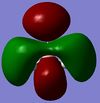 |
-0.17929 |
| 4 |  |
-0.35079 | 8 |  |
-0.17929 |
Questions
Question 1: Are there any significant differences between the real and LCAO MOs?
Answer 1: There are no significant differences between the real and LCAO MOs where they were pretty much the same in shape and polarity. There was only a slight difference as the unoccupied real MO orbitals were slightly more diffused than the occupied MOs. On the other hand, the LCAO MOs does not have such diffusion. The form of the unoccupied real MOs (the highest e' degerate orbitals) were slightly odd compared to the LCAO ones.
Qusetion 2: What does this say about the accuracy and usefulness of qualitative MO theory?
Answer 2: The accuracy and usefulness of qualitative MO theory was excellent. It was able to predict and reproduce the same results as the computed ones qualitatively. This was great as it does not involve heavy computational calculations and can be worked out via pen and paper with ease. Also, it was easy to describe and explain to people. However, in terms of quantitative results, it was not very accurate and hard to predict the positions of the exact energy levels as when reaches larger molecules, the orbital interactions would become more complicated.
NBO Analysis of NH3
Optimisation of NH3
Computational analysis of NH3 was investigated using Gaussian 09. It was optimized using the DFT B3LYP/6-31G(d,p)calculations. Other than that, to ensure that the calculation is more accurate, the geometry was restricted to C3v, with the tolerance set to be very tight (0.0001). Additional keyword of SCF=conver=9 and int=ultrafine with tight convergence criteria were used to ensure that the calculation of electron distribution would converge more precisely. The log data of the calculation would be found from the link below:
The data below shows the details and results of the calculation. The energy obtained was -56.55776873 a.u. The optimisation was complete as the RMS gradient is less than 0.001 a.u.
| File Type | .log |
| Calculation Type | FOPT |
| Calculation Method | RB3LYP |
| Basis Set | 6-31G(d,p) |
| Charge | 0 |
| Spin | Singlet |
| E(RB3LYP) | -56.55776873 a.u. |
| RMS Gradient Norm | 0.00000323 a.u. |
| Imaginary Freq | nil |
| Dipole Moment | 1.8465 Debye |
| Point Group | C3v |
| Job cpu time | 16.0 seconds |
Also, the job had already converged. It was proven from the data below showing that the full convergence after the job.
Item Value Threshold Converged?
Maximum Force 0.000006 0.000015 YES
RMS Force 0.000004 0.000010 YES
Maximum Displacement 0.000012 0.000060 YES
RMS Displacement 0.000008 0.000040 YES
Predicted change in Energy=-9.846588D-11
Optimization completed.
-- Stationary point found.
From the calculation, it was found that NH3 has the following data for bond length and bond angle.
Bond length (N-H): 1.01798 Å
Bond angle (H-N-H): 106 deg.
Frequency analysis of NH3
After the optimisation, the calculation was proceeded with the frequency calculation of NH3. The log file of the data was found from the link below:
The data below shows the details and the results of the calculation. The energy obtained was -56.55776873 a.u., which is similar to the energy obtained from the optimisation above. The frequency calculation was completed as the RMS Gradient Norm is less than 0.001 a.u.
| File Type | .log |
| Calculation Type | FREQ |
| Calculation Method | RB3LYP |
| Basis Set | 6-31G(d,p) |
| Charge | 0 |
| Spin | Singlet |
| E(RB3LYP) | -56.55776873 a.u. |
| RMS Gradient Norm | 0.00000323 a.u. |
| Imaginary Freq | nil |
| Dipole Moment | 1.8465 Debye |
| Point Group | C3v |
| Job cpu time | 4.0 seconds |
Also, the job had already converged. It was proven from the data below showing that the full convergence after the job.
Item Value Threshold Converged?
Maximum Force 0.000006 0.000450 YES
RMS Force 0.000003 0.000300 YES
Maximum Displacement 0.000013 0.001800 YES
RMS Displacement 0.000007 0.001200 YES
Predicted change in Energy=-1.130104D-10
Optimization completed.
-- Stationary point found.
The two lines of frequencies found from the log file was shown below:
Low frequencies --- -0.0129 -0.0014 0.0017 7.0722 8.1014 8.1017 <br> Low frequencies --- 1089.3849 1693.9369 1693.9369
From the calculation, it was found that NH3 has the following data for bond length and bond angle.
Bond length (N-H): 1.01798 Å
Bond angle (H-N-H): 106 deg.
The computed IR spectrum of NH3 was as shown below:
There are less than six peaks in the spectrum because IR spetrum only records vibrations that results in change in dipole moment. Thus those symmetrical stretches would not show up in the IR spectrum.
NBO details
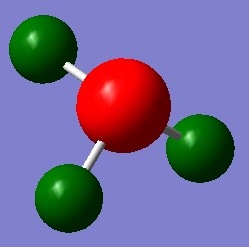

The link below shows the log file for the population computation that was performed to ammonia.
From Figure 1, it shows the image of the charge distribution of NH3. The bright red color indicates highly negative charge is deposited on the N atom while the H atoms have green color which indicate that positive charge is deposited on the atoms. It was reasonable as nitrogen is much more electronegative than hydrogen atoms and thus would pull electron density towards itself more. Also, it as a lone pair which could attribute to its highly negative charge. In Figure 2, it shows the numerical charges deposited on the atoms individually. The nitrogen atoms exceeded the maximum -1.000 charge range most probably due to the lone pair on the nitrogen.
The charge range was -1.000 to +1.000.
NBO charges for Nitrogen was -1.125 while Hydrogen was 0.375.
Association energies of Ammonia-Borane
Optimisation of Ammonia-Borane
Computational analysis of NH3BH3 was investigated using Gaussian 09. It was optimized using the DFT B3LYP/6-31G(d,p)calculations. Additional keyword of SCF=conver=9 and int=ultrafine with tight convergence criteria were used to ensure that the calculation of electron distribution would converge more precisely. The log data of the calculation would be found from the link below:
The data below shows the details and results of the calculation. The energy obtained was -83.22468906 a.u. The optimisation was complete as the RMS gradient is less than 0.001 a.u.
| File Type | .log |
| Calculation Type | FOPT |
| Calculation Method | RB3LYP |
| Basis Set | 6-31G(d,p) |
| Charge | 0 |
| Spin | Singlet |
| E(RB3LYP) | -83.22468906 a.u. |
| RMS Gradient Norm | 0.00000124 a.u. |
| Imaginary Freq | nil |
| Dipole Moment | 5.5646 Debye |
| Point Group | C1 |
| Job cpu time | 53.0 seconds |
Also, the job had already converged. It was proven from the data below showing that the full convergence after the job.
Item Value Threshold Converged?
Maximum Force 0.000002 0.000015 YES
RMS Force 0.000001 0.000010 YES
Maximum Displacement 0.000026 0.000060 YES
RMS Displacement 0.000009 0.000040 YES
Predicted change in Energy=-8.957668D-11
Optimization completed.
-- Stationary point found.
From the calculation, it was found that NH3BH3 has the following data for bond length and bond angle. Bond length (B-H): 1.20977 Å Bond length (B-N): 1.66771 Å Bond length (N-H): 1.01847 Å Bond angle (H-N-H): 108 deg. Bond angle (H-B-H): 114 deg.
Frequency analysis of Ammonia-Borane
After the optimisation, the calculation was proceeded with the frequency calculation of NH3BH3. The log file of the data was found from the link below:
The data below shows the details and the results of the calculation. The energy obtained was -83.22468901 a.u., which is similar to the energy obtained from the optimisation above. The frequency calculation was completed as the RMS Gradient Norm is less than 0.001 a.u.
| File Type | .log |
| Calculation Type | FREQ |
| Calculation Method | RB3LYP |
| Basis Set | 6-31G(d,p) |
| Charge | 0 |
| Spin | Singlet |
| E(RB3LYP) | -83.22468901 a.u. |
| RMS Gradient Norm | 0.00000117 a.u. |
| Imaginary Freq | nil |
| Dipole Moment | 5.5647 Debye |
| Point Group | C1 |
| Job cpu time | 30.0 seconds |
Also, the job had already converged. It was proven from the data below showing that the full convergence after the job.
Item Value Threshold Converged?
Maximum Force 0.000003 0.000450 YES
RMS Force 0.000001 0.000300 YES
Maximum Displacement 0.000021 0.001800 YES
RMS Displacement 0.000011 0.001200 YES
Predicted change in Energy=-9.992352D-11
Optimization completed.
-- Stationary point found.
The two lines of frequencies found from the log file was shown below:
Low frequencies --- -6.4821 -5.7249 0.0006 0.0009 0.0012 2.5218 Low frequencies --- 263.3900 632.9503 638.3834
From the calculation, it was found that NH3BH3 has the following data for bond length and bond angle. Bond length (B-H): 1.20977 Å Bond length (B-N): 1.66771 Å Bond length (N-H): 1.01847 Å Bond angle (H-N-H): 108 deg. Bond angle (H-B-H): 114 deg.
Calculation of association energy
E(NH3)= -56.55476873 a.u.
E(BH3)= -26.61532364 a.u.
E(NH3BH3)= -83.22468901 a.u.
ΔE=E(NH3BH3)-[E(NH3)+E(BH3)]= -83.22468901+56.55476873+26.61532364 = -0.05459664 a.u.
Association energy = Dissociation energy = -0.05459664 a.u. = - 143.34347832 kJ/mol

